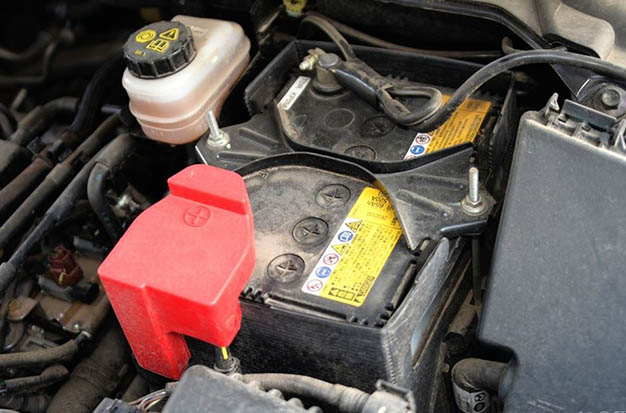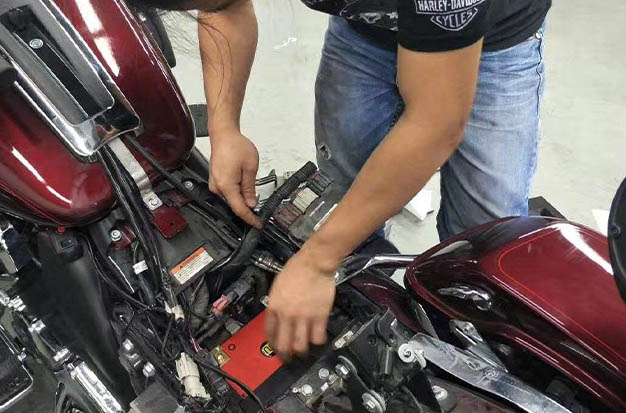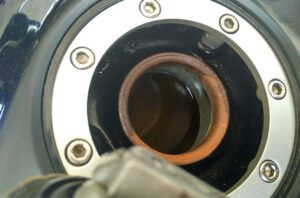How do you disconnect motorcycle battery?
Is this a thought that goes through your head? Do you believe that detonating a bomb is comparable to disconnecting the battery from your motorcycle or scooter?
You’ll be glad to know that it isn’t, but you should be aware of a few things to keep yourself safe.
Should I Disconnect The Battery From My Motorcycle?
Your motorcycle’s battery can be compared to the machine’s heart because it powers the electrical systems and enables the engine to start. So, it’s important to keep it healthy and strong.
Connecting the battery when the bike isn’t in use is one way to achieve this. This will stop the battery from being drained even when the bike is not running.
When a battery isn’t in use, it self-discharges, so it’s crucial to keep it on a maintainer (a gadget that trickle-charges the battery) to keep it from sulfating. The battery is permanently harmed by sulfation, which also lowers the battery’s capacity to hold a charge.
So, to keep your motorcycle battery healthy and strong, it’s best to disconnect it when you’re not using the bike and to keep it on a maintainer at all times.
In addition, you can avoid your battery dying by unplugging it whenever you’re not using it. The battery will self-discharge even if there isn’t any load on it. Batteries become sulfated and may never again be able to be charged if they are left discharged. The ideal scenario is to always have your battery on a maintainer.
10 Reasons Why Disconnect Motorcycle Battery
The motorcycle battery shouldn’t even need to be disconnected, so why would it? There are a number of circumstances in which you must disconnect the motorcycle battery, so your query is valid. The majority of the explanations have to do with problem-solving. Disconnecting the battery is necessary before each battery check. Be aware of a few causes for why you might want to unplug a motorcycle battery.
Lack Of Charge
You cannot operate the motorcycle effectively if the battery is not fully charged. Lack of charge causes a condition called sulfation. The battery life was shortened by this issue. Detaching the motorcycle’s battery and charging it right away are therefore essential. The best motorcycle performance comes from a fully charged battery.
Dim Headlight, Low Horn
Most of the issues related to the performance of the motorcycle are caused due to a low battery. Low horns and dim headlights are some warning signs. This is possibly a battery problem when the light is dark, and the horn isn’t loud enough. If this is the case, you might need to change the battery or unlink it in order to diagnose the issue.
Starting Problem
The motorcycle’s battery may not be functioning properly if it’s difficult for you to start it. The bike can’t be started because of the battery’s inefficiency. As a result, the motorcycle won’t start when you insert the key. Dead batteries are one potential cause of this. When this occurs, you should unplug the motorcycle battery and examine it.
Electrical Connection Issues
Electrical connections have been added to modern motorcycle batteries to boost their performance. Building an electrical connection requires connecting positive and negative wiring. The battery, however, performs poorly when these connections are slack or inactive. You would need to detach the wiring and correct the electrical faults in this case.
Distorted Battery
An overused and burned battery would distort. The battery is no longer useful even with a small amount of distortion. If so, you would need to get a new battery. To replace the battery, first unplug the cables, then take the battery out. The best performance comes from a fresh battery.
Fluctuating Voltage Reading
The voltage reading on the multimeter would be constant if the battery functions correctly. However, if the reading changes, there may be a battery problem. The connections are fragile, and the battery is probably in a vulnerable condition. Remove and disconnect the battery to correct this. Inspect the device for errors, and if necessary, purchase a new battery.
Leakage
Overcharging the battery or using an outdated battery can result in serious leakages because of temperature changes. Leakages are dangerous as they would cause ignition and harmful reactions. If you ever notice a leak, you should immediately cut the terminals off and take them off the motorcycle. Clean the area and then install the battery.
Cleaning
For your safety, remember to disconnect the battery circuit if you plan to clean the battery. It is best to unplug the cables and take the battery out of the cage. This cleaning technique is efficient and secure. For proper upkeep, try cleaning the battery once every two months. Additionally, disconnect the battery first if you plan to do it yourself for safety.
Corrosion
The battery terminals start to corrode over time. In addition, the battery’s other components begin to corrode, er, wear. Cleaning the battery can occasionally help you restrict these circumstances. The battery must be unplugged from the circuit before being cleaned or replaced.
Needs Replacement
You should change the motorcycle battery every three to five years. This is necessary to extend the life of the motorcycle and its engine. Else, if you face any severe problems, consider replacing the battery.
The battery must first be removed in order to replace it, followed by the wirings. While installing, make sure to reconnect the cables properly. These are the potential causes for why you might need to disconnect a motorcycle battery.

How To Disconnect A Motorcycle Battery: 5 Steps
Because the motorcycle battery is the vehicle’s power source, you cannot afford to have a defective battery. It is crucial to assess the motorcycle battery’s condition whenever a problem arises. However, it’s not as simple as it might seem. There is a sure way to do it. So here is how you can disconnect and remove the motorcycle battery safely.
Step 1: Check The Manual
Please read the manual before I explain the procedure. The manual generally has specific instructions on how to troubleshoot a particular problem. Therefore, the manual may be the only source for the needed solution.
In addition, the manual includes numerous instructions for removing the battery. It makes reference to the motorcycle’s battery’s location. Some brands offer user guides with comprehensive instructions for fixing battery issues. So don’t hesitate to read the company manual. In times of need, it can be very useful.
Step 2: Locate The Battery
There are batteries in various locations on various motorcycle models. For example, the luxury brands like Harley Davidson have batteries extending out to the right side of the motorcycle. Batteries are located on the bottom side of some bike brands.
But commonly, the batteries are located beneath the motorcycle seat or near the fuel tank. To find out where the battery is, you can once again consult the manual. Once you’ve found it, get to the battery.
Remove the seat or open the covering to find the battery near the fuel tank. Now that you can see the battery, it’s time to disconnect it.
Step 3: Delink The Black Cable
Typically, the connection’s negative pole is represented by the black cable. It is crucial to unlink the black cable first to avoid electric shocks. To make sure that the cable is the negative wire, look for a minus sign on it. The issue with doing otherwise is the positive wire may conduct electricity under certain circumstances.
The metal around the positive wire is frequently used as grounding. Fuse or fire still have a chance to blow when the positive wire is disconnected first. This could result in a serious and deadly accident. Detach the negative cable first to avoid any mishaps.
Step 4: Unlink The Positive Wiring
Once you unlink the black wire, the entire circuit connection is disrupted. Since all bonds have now been broken, the positive wiring can be safely removed. The standard marking for this is a plus sign in the color red. As you locate the wire, remove it from the circuit. The battery can now be discharged. The disconnection part is done!
Step 5: Take Out The Battery
It’s possible to see the battery’s retaining bracket wrapped around it. Others are enclosed inside a metal bracket, while some have rubber belts. Unscrew these brackets with a screwdriver or wrench and remove them from the battery.
Take the motorcycle battery out of the cage right now. The battery should not be tilted as this could result in a lead leak. The battery parts may also get bumped to the motorcycle frame tilted. Holding the strap, pull it straight out. That is it!
How To Connect A Motorcycle Battery?
If you’re like most motorcycle enthusiasts, you like to do as much of your own maintenance and repairs as possible. After all, having a motorcycle is fun in and of itself. But when it comes to electrical work, it’s important to be extra careful. One mistake can fry your bike’s electrical system and leave you stranded on the side of the road.
We’ll demonstrate safe motorcycle battery connection in this article. Additionally, we’ll provide you with some advice on how to maintain the health and extend the life of your battery.
Let’s first discuss the reasons why handling a motorcycle battery safely is so crucial. A motorcycle battery is exposed to the elements unlike a car battery. This means that it is more prone to rust and damage.
Additionally, compared to car batteries, motorcycle batteries are typically smaller and less powerful. Since they can discharge more quickly, they are more likely to run out if you accidentally leave your bike’s lights on.
It’s crucial to exercise extra caution when working with motorcycle batteries due to all of these factors. Make sure you have a good understanding of the basics before you start tinkering.
After getting that out of the way, let’s get to the point. The proper way to connect a motorcycle battery is shown here.
1. Start by removing the outdated motorcycle battery. To remove the battery tray bolts, you’ll need a Phillips head screwdriver. Lift the tray out and place it aside after the bolts have been taken out.
2. Remove the negative (-) cable from the battery terminal. This cable is black.
3. The battery terminal’s positive (+) cable should be disconnected. The red cable is this.
4. Clean the battery terminals with a wire brush. Any corrosion that has accumulated on the terminals can be reduced by doing this.
5. To the motorcycle, connect the new battery. Start by connecting the positive (+) cable to the battery terminal. The negative (-) cable should then be connected.
6. Place the battery tray back in place and fasten it with the bolts.
7. Start the motorcycle to test the replacement battery. If everything is functioning properly, you’re good to go!
The following advice will help you extend the life of your motorcycle battery now that you know how to connect it securely:
– Store the battery in a cool, dry place when you’re not using the motorcycle.
– On a regular basis, look for corrosion on the battery terminals.
– Keep an eye on the battery’s electrolyte level and top it off if necessary.
– Avoid running the battery down all the way. Try to maintain a charge of at least 50%.
By following these simple tips, you can help ensure that your motorcycle battery has a long and healthy life.
Which Battery Terminal Do You Disconnect First On A Motorcycle?
The negative cable is the cable that is attached to the negative terminal of the battery. This is the terminal denoted by a minus (-) sign. When the negative cable is cut, the battery’s negative terminal is also cut off from the rest of the electrical system. When working on your motorcycle, you should unplug this cable first.
The connection between a negative battery terminal and a negative point on a circuit is made using a negative cable, a type of electrical cable. Typically made of copper or another conductor, this kind of cable is insulated to guard against electric shock.
How Do I Unhook My Motorcycle Battery?
If you’re like the majority of motorcycle riders, you probably don’t think much about your battery until it stops starting your motorcycle. Then, it’s all you can think about!
If your battery has died, or if you’re having trouble starting your bike, there are a few things you can do to try to get it going again. One choice is to disconnect the battery and connect a charger to it. It will have a chance to recharge as a result, which might be all the battery needs to get going once more.
But if the battery is completely dead, you might have to change it. Although it’s a simple process, it’s crucial to get the proper battery for your bike. You can usually find the right battery at your local motorcycle shop or online.
Simply connect your bike to a new battery once you have one, and you should be good to go!
How Do I Connect A Motorcycle Or Scooter Battery?
So you’re done working on either your battery or your electrics. All that remains now is to connect the battery back.
Additionally, there is a specific order in which the battery must be reconnected, just like when it was disconnected.
It’s essentially the same order in which you disconnected your battery – except in reverse.
So to reconnect the battery, you must first connect the red cable to the positive terminal.
The black cable can then be connected to the negative terminal after the red one has been connected.
When you do this, there might be a few sparks, but as long as your hands are off the terminal, you shouldn’t experience any problems.
After Disconnecting A Motorcycle Battery, Is It Safe To Leave It There?
After disconnecting the battery, it is not advisable to leave the motorcycle running. This is because the motorcycle parts consume tad-bit electricity even after disconnecting the battery. The battery slowly runs out of charge when left in the motorcycle. Additionally, it could cause sulfation, which would significantly shorten the battery’s lifespan.
The best course of action is to remove the motorcycle battery after disconnecting it and store it indoors, preferably in a maintainer. When kept outside, the battery may become harmed by temperature changes. In order to keep the battery reasonable, you should store it in a battery charging maintainer.
Conclusion
If you’re ready to disconnect your motorcycle battery, here’s what you need to do:
- Make sure your motorcycle is turned off.
- Locate the battery’s negative terminal.
- The bolt on the negative terminal can be loosened using a wrench.
- Pull the negative terminal off the battery.
- Track down your battery’s positive terminal.
- To remove the bolt from the positive terminal, use a wrench.
- Remove the battery by yanking the positive terminal.
Finally, your motorcycle battery has been successfully disconnected.
Read More: How Long Does It Take To Charge A Motorcycle Battery?



